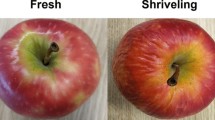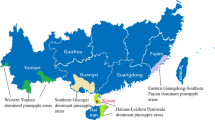Abstract
Tamarind (Tamarindus indica L.) is a tropical fruit tree highly valued for its fruit pulp. It has been identified as one of the priority species with great potential for domestication in the Sahelian countries of Sub-Saharan Africa. An important step in the domestication process is the characterization of the local natural variation of the species in order to select the most interesting phenotypes/genotypes which possess several desired traits for breeding purposes. Four provenances covering contrasting agro-ecological zones in Mali were selected for fruit morphological and nutritional traits (tartaric acid and sugars). Tamarind trees from the driest provenance contained smaller fruits with a smaller amount of pulp compared to provenances from wetter zones. Tamarind trees in Mali have a low real pulp value (maximum 9.5) and bear sour fruits (high tartaric acid content of 9–12 %). Some sweet-fruited trees could be identified, but the sweetness was low (maximum 8). Fruit traits seem to be influenced by climate and soil characteristics, which should be taken into account in the domestication process, when planting trees in a different region of origin. We selected a few elite trees within each provenance, containing the best combination for the most desirable fruit traits, using web diagrams. Frequency distributions of the different fruit traits showed some traits are probably the target of selection by farmers. All provenances, except the driest one, indicated a possible very first stage of domestication.








Similar content being viewed by others
Notes
The acronym DADOBAT stands for Domestication And Development of Baobab and Tamarind. The DADOBAT project was funded during the 2006–2010 period by the European Commission under the Sixth Framework Programme and aimed to develop sustainable production systems for baobab (Adansonia digitata L.) and tamarind (Tamarindus indica L.) in West Africa (Benin, Mali and Senegal) based on characterization, conservation and use of local genetic resources.
References
Adeola A, Aworh O (2010) Sugar and dietary fibre components of tamarind (Tamarindus indica L.) fruits from Nigeria. Niger Food J 28(2):32–40
Akinnifesi FK, Leaky RRB, Ajayi OC, Gudeta S, Tchoundjeu Z, Matakala P, Kwesiga FR (2008) Indigenous Fruit Trees in the Tropics: Domestication. Utilization and Commercialization, CAB International
Anon (1976) Tamarindus indica L. In: The Wealth of India (Raw Materials Series). Council of Scientific and Industrial Research, vol 144–122. New Delhi, India
Anon (1982) Some recent developments. Central Food Technological Research Institute, Mysore, India
Assogbadjo AE, Sinsin B, Codjia JTC, Van Damme P (2005) Ecological diversity and pulp, seed and kernel production of the baobab (Adansonia digitata) in Benin. Belg J Bot 138:47–56
Bourou S, Bowe C, Diouf M, Van Damme P (2012) Ecological and human impacts on stand density and distribution of tamarind (Tamarindus indica L.) in Senegal. Afr J Ecol 50:253–265
CUC, Centre for Underutilised Crops (2010) Tamarinier: Tamarindus indica, Manuel pratique pour des médiateurs et paysans. University of Southampton, Southampton
Cuni Sanchez A, De Smedt S, Haq N, Samson R (2011) Comparative study on baobab fruit morphological variation between Western and South-eastern Africa: opportunities for domestication. Genet Resour Crop Evol 58:1143–1156
Dawson IK, Powell W (1999) Genetic variation in the Afromontane tree Prunus africana, an endangered medicinal species. Mol Ecol 8:151–156
De Caluwé E, Halamová K, Van Damme P (2010) Tamarindus indica L.—a review of traditional uses, phytochemistry and pharmacology. Afr Focus 23:53–83
De Smedt S, Alaerts K, Kouyaté AM, Van Damme P, Potters G, Samson R (2011) Phenotypic variation of baobab (Adansonia digitata L.) fruit traits in Mali. Agrofor Syst 82:87–97
Diallo B, Joly H, McKey D, Hossaert-McKey M, Chevallier M-H (2007) Genetic diversity of Tamarindus indica populations: any clues on the origin from its current distribution? Afr J Biotechnol 6:853–860
Diallo BO, Mckey D, Chevallier M-H, Joly HI, Hossaert-Mckey M (2008) Breeding system and pollination biology of the semi-domesticated fruit tree, Tamarindus indica L. (Leguminosae: Caesalpinioideae): implication for fruit production, selective breeding, and conservation of genetic resources. Afr J Biotechnol 7:4068–4075
Dokoozlian NK (2000) Grape berry growth and development. In: Peter Christensen L (ed) Raison production manual. University of California, Davis, pp 30–37
El-Siddig K, Ebert G, Luedders P (1999) Tamarind (Tamarindus indica L.): a review on a multipurpose tree with promising future in the Sudan. J Appl Bot Angew Bot 73:5–6
El-Siddig K, Gunasena H, Prasad B, Pushpakumara D, Ramana K, Vijayanand P, Williams J (2006) Tamarind, Tamarindus indica L. Fruits for the future 1. CUC-Southampton Centre for Underutilized Crops, Southampton
Fandohan B, Assogbadjo A, Glèlè Kakaï R, Kyndt T, Sinsin B (2011) Quantitative morphological descriptors confirm traditionally classified morphotypes of Tamarindus indica L. fruits. Genet Resour Crop Evol 58:299–309
FAO (1988) Fruit bearing trees. Technical notes. FAO-SIDA Forestry Paper 34:165–167
FAO (2001) State of forest genetic resources in Sahelian and north-Sudanian Africa and Regional action plan for their conservation and sustainable use. Forest genetic resources Working Papers, Working Paper 2. Technical report, FAO, Forest Resources Development Service, Forest Resources Division, Rome, Italy
Feungchan S, Yimsawat T, Chindaprasert S, Kitpowsong P (1996) Evaluation of tamarind cultivars on the chemical composition of pulp. Thai J Agric Sci (1):28–33
Hasan SK, Ijaz S (1972) Tamarind—a review. Sci Ind (Karachi) 9:131–137
Havinga RM, Hartl A, Putscher J, Prehsler S, Buchmann C, Vogl CR (2010) Tamarindus indica L. (Fabaceae): patterns of use in traditional African medicine. J Ethnopharmacol 127:573–588
Hijmans RJ, Cameron SE, Parra JL, Jones PG, Jarvis A (2005) Very high resolution interpolated climate surfaces for global land areas. Int J Climatol 25:1965–1978
Hothorn T, Bretz F, Westfall P, Heiberger RM, Schuetzenmeister A, R Development Core Team (2008) Multcomp: simultaneous inference in general parametric models
Kalinganire A, Weber J, Uwamariya A, Kone B (2008) Improving rural livelihoods through domestication of indigenous fruit trees in the parklands of the Sahel. In: Akkinifesi F, Leaky R, Ajayi O, Sileshi G, Tchoundjeu Z, Matakala P, Kwesiga F (eds) Indigenous fruit trees in the tropics: domestication, utilization and commercialization, chapter 10. CAB International, Oxfordshire, pp 186–203
Knapp DR (1979) Handbook of analytical derivatisation reactions. Wiley, New York
Kouyaté AM, Van Damme P (2002) Caractères morphologiques de Detarium microcarpum Guill. et Perr. au sud du Mali. Fruits 57:231–238
Kulkarni RS, Gangaprasad S, Swamy GSK (1993) Tamarind: economically an important minor forest product. Minor For Prod News 3:6
Leaky RRB (2005) Domestication potential of marula (Sclerocarya birrea subsp. caffra) in South Africa and Namibia:3. Multiple trait selection. Agrofor Syst 64:51–59
Leaky RRB, Tchoundjeu Z, Smith RI, Munro RC, Fondoun J-MF, Kengue J, Anegbeh PO, Atangana AR, Waruhiu AN, Asaah E, Usoro C, Ukafor V (2004) Evidence that subsistence farmers have domesticated indigenous fruits (Dacryodes edulis and Irvingia gabonensis) in Cameroon and Nigeria. Agrofor Syst 60:101–111
Lewis YS, Neelakantan S, Bhatia DS (1961) Organic acid metabolism in tamarind leaves. Curr Sci India 30:381
Lim TK (2012) Edible Medicinal and Non-Medicinal Plants, Vol 2, Fruits. Vol 4, Springer, the Netherlands
Maranz S, Wiesman Z (2003) Evidence for indigenous selection and distribution of shea tree, Vitellaria paradoxa, and its potential significance to prevailing parkland savanna tree patterns in sub-Saharan Africa north of the equator. J Biogeogr 30:1505–1516
Patnaik KK (1974) Seasonal pattern of tartaric acid metabolism underlying the phasic development in Tamarindus indica. Biol Plant 16:1
Peyrot des Gachons C, Van Leeuwen C, Tominaga T, Soyer J-P, Gaudillere J-P, Dubourdieu D (2005) Influence of water and nitrogen deficit on fruit ripening and aroma potential of Vitis vinifera L. cv. Sauvignon blanc in field conditions. J Sci Food Agric 85:73–85
Pinheiro JC, Bates DM, DebRoy S, Sarkar D, R Development Core Team (2009) Nmle: linear and nonlinear mixed effects models
R Development Core Team (2009) R: A language and environment for statistical computing. R Foundation for Statistical Computing, Vienna
Simbo DJ, De Smedt S, Van den Bilcke N, De Meulenaer B, Van Camp J, Uytterhoeven V, Tack F, Samson R (2013) Opportunities for domesticating the African baobab (Adansonia digitata L.): multi-trait fruit selection. Agrofor Syst 87:493–505
Soloviev P, Niang TD, Gaye A, Totte A (2004) Variability of fruit physicochemical characters for three harvested woody species in Senegal: Adansonia digitata, Balanites aegyptiaca and Tamarindus indica [French]. Fruits 59:109–119
Ugese FD, Baiyeri PK, Mbah BN (2010) Agroecological variation in the fruits and nuts of shea butter tree (Vitellaria paradoxa C.F. Gaertn.) in Nigeria. Agrofor Syst 79:201–211
Acknowledgments
We are thankful to Prof. Dr. Eng. John Van Camp, Prof. Dr. Eng. Bruno De Meulenaer, Eng. Sofie Coelus and Nathalie De Muer from the department of Food Safety and Food Quality (Ghent University, Belgium) for the training in the nutritional analysis of the tamarind fruits. The first author is granted by a PhD. funding of the Agency for Innovation by Science and Technology in Flanders (Belgium) (I.W.T. Vlaanderen). The second author was also granted by a I.W.T. funding.
Author information
Authors and Affiliations
Corresponding authors
Rights and permissions
About this article
Cite this article
Van den Bilcke, N., Alaerts, K., Ghaffaripour, S. et al. Physico-chemical properties of tamarind (Tamarindus indica L.) fruits from Mali: selection of elite trees for domestication. Genet Resour Crop Evol 61, 537–553 (2014). https://doi.org/10.1007/s10722-014-0080-y
Received:
Accepted:
Published:
Issue Date:
DOI: https://doi.org/10.1007/s10722-014-0080-y




